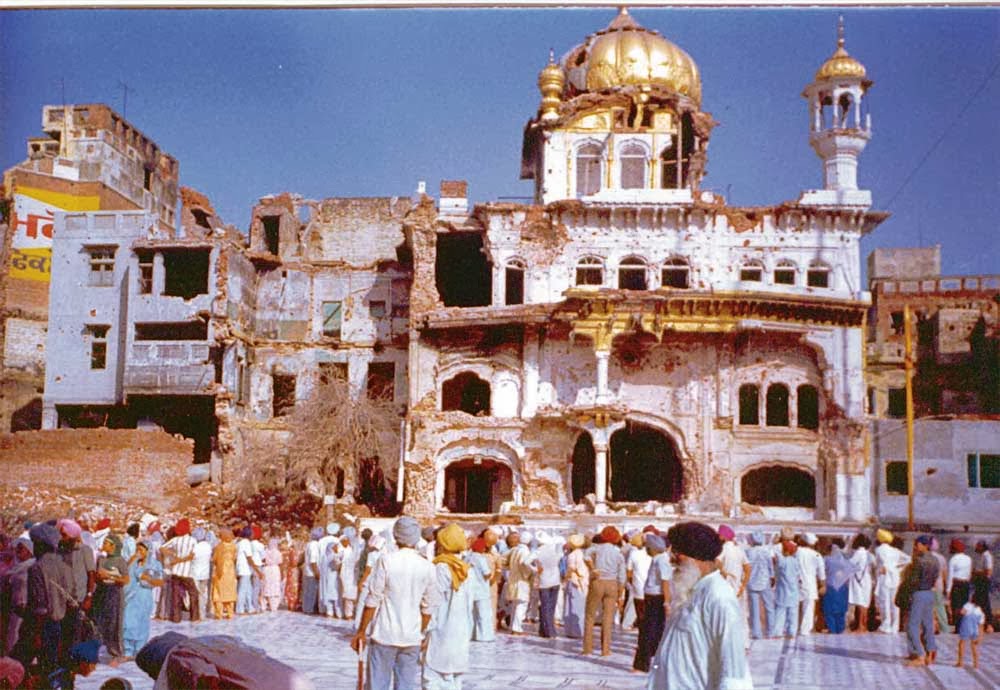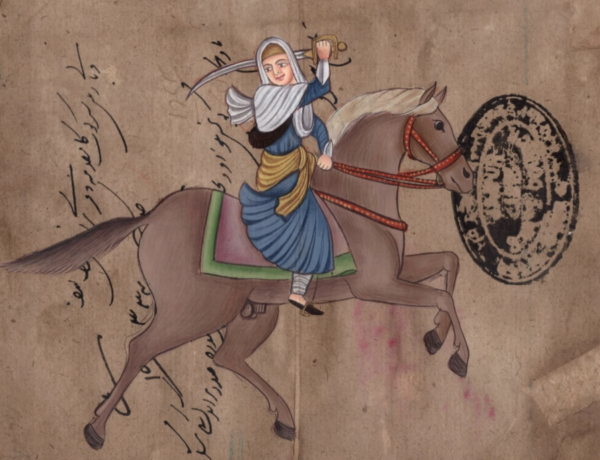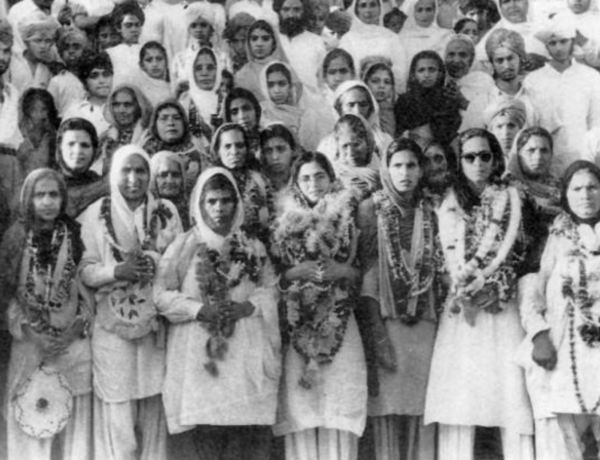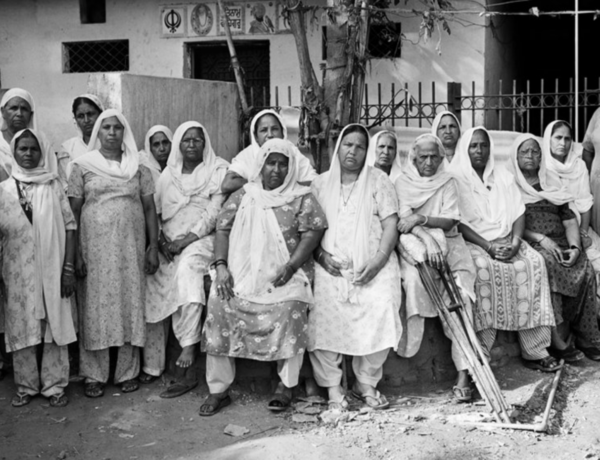by Lakhpreet Kaur
Introduction
In early June of 1984, the Indian Army invaded Harmandir Sahib under the orders of Indian Prime Minister Indira Gandhi to “flush out Sikh terrorists”; the official name was “Operation Blue Star“. During the invasion, the army killed thousands of Sikh civilians. Then on October 31, 1984, after the assassination of Indira Gandhi, the Indian Government orchestrated anti-Sikh pogroms across India which lead to the murder of thousands more.
In the Sikh Panth, these attacks are colloquially referred to as “1984” and have shaped the collective Sikh psyche.
This series of three articles hopes to serve as a brief introduction to the events of 1984 and to provide a starting point for those interested in learning about the historical events. So the information is accessible to everyone, we will not be sharing graphic descriptions or triggering details. Rather, we will share with you resources where you can read eye witness accounts, if you are interested.
Before we start, we would like to take this opportunity to honor the Singhs and Kaurs affected by the violence of 1984, and the shaheeds who laid down their lives defending the Panth.
Part 1: The Anti-Sikh Violence of 1984 | The Background
Part 2: The Anti-Sikh Violence of 1984 | The Battle of Amritsar (aka Operation Bluestar)
Part 3: The Anti-Sikh Violence of 1984 | Anti-Sikh Pogroms
The June 1984 Ghallughara (aka Operation Bluestar)
While Sikhs were mobilizing and fighting for civil liberties, the Indian Government had started planning an assault on the Harmandir Sahib complex in the early 1980s. This attack was officially known as “Operation Bluestar” and known in Sikh spaces as “The June 1984 Ghallughara (holocaust)” or “The 1984 Battle of Amritsar”.
While mainstream reports portray the attack as a last-resort, quick action by the government, evidence indicates otherwise. “The army action was not the ‘last resort’ as Prime Minister Indira Gandhi would have us believe. It had been in her mind for more than 18 months,” said Retired Lt-General S.K. Sinha, (Sikh Research Institute). It seems that Indira Ghandi directed the Indian Army to prepare for an attack on Harmandir by constructing a model of Darbar Sahib shortly after the Dharam Yudh Morcha started and long before Baba Jarnail Singh entered into the Akal Takat.
The British Government was also aiding the Indian Army’s plans months before the attack. The United Kingdom’s Thatcher Government was aware of the Indian Government’s plan to invade Harmandir Sahib, and had provided a Special Air Service officer to advise the Indian authorities. This and other assistance was intended to safeguard the UK’s arms sales to India, (Syal, Miller, 2014).
As the government was orchestrating the attack, it was also weaving a narrative to pitch to the public to justify their action. Subramanian Swamy of the Indian Parliament wrote that the Congress Government claimed that hundreds of terrorist had taken refuge in the gurdwara. Claiming it necessary to “flush out Baba Jarnail Singh and other alleged terrorists from the Darbar Sahib,” (Kaur, 2004, pg. 29), Indira Gandhi mobilized the army to execute her plans.
In June 1984, the Indian Army invaded Harmandir Sahib under the orders of Indian Prime Minister Indira Gandhi. Below is a timeline of events in June 1984 compiled from the Sikh Research Institute and “Lost in History: 1984 Reconstructed” by Gunisha Kaur, unless otherwise noted.
Note: We have mentioned a few Kaur shaheeds. To learn about other Kaurs and Singh shaheeds, visit 1984 Tribute.
June 1, 1984
- Thousands of Sikhs gather at Harmandir Sahib to commemorate Guru Arjan Sahib’s shaheedi.
- The Indian Army surrounds the Harmandir Sahib complex and opens fire. Several people were killed. Despite being contrary to physical evidence and eyewitness testimony, All India Radio reports that shots came from within Harmandir Sahib.
June 2, 1984
- The Indian Government transfers authority over the Harmandir Sahib standoff to the military.
- Troops begin establishing operations in the surrounding area; at least seven divisions of the army are deployed in Punjabi villages.
- By nightfall, the media and the press are gagged; the rail road and air services in Punjab are suspended.
- Foreigners and non-resident Indians (NRIs) are banned from entering Punjab.
- Water and electricity is cut off from the Harmandir Sahib complex and other gurdwaras in Amritsar.
Jun 3, 1984
- Guru Arjan Sahib Ji’s Shaheedi Day.
- The army and paramilitary are patrolling Punjab which is now under complete curfew.
- The army seals off all exits to/from Sri Harmandir Sahib complex. As many as 10,000 pilgrims are trapped inside.
- All communications, including phone lines to and from Punjab are cut.
- Roadblocks prevent anyone from entering or leaving Punjab.
- Journalists are expelled from Punjab.
June 4, 1984
- The army starts firing, resulting in a gun battle that lasts 5 hours. 100 people are killed on both sides.
June 5, 1984
- 7:00 pm Operation Blue Star, the invasion of Harmandir Sahib, begins with tanks of the 16th Cavalry Regiment of the Indian Army moving to enclose the complex.
- Artillery is used to blast off the tops of the Ramgarhi Bunga and water tanks
- 10:30 pm commandos from the Parachute Regiment try to run down to the parkarma.
June 6, 1984
- Tanks are used to break down the steps leading to the parkarma.
- An armored personnel carrier makes its way towards Akal Takht.
- The Akal Takht is destroyed by a rocket propelled grenade launcher.
- Tanks start firing cannons at the Akal Takht.
- The army troops are given the order to storm the remains of the Akal Takht and shoot-on-site anyone inside.
- Bibi Upkar Kaur (of Karnal, Haryana) was the president of the Girls Wing of All India Students Federation. She encouraged other Kaurs to fight for justice and equality and take equal part with men. She and other young women in the organization, like Bibi Paramjit Kaur, achieved shaheedi on June 6 within Harmandir Sahib.
- Bibi Pritam Kaur and her husband Bhai Mohar Singh, along with their two daughters, Bibi Satnam Kaur (age 8), and Bibi Waheguru Kaur (age 6), were close to Baba Jarnail Singh and with him during the attack. During the attack, Bibi Pritam Kaur and her daughters refilled the Singhs’ ammunition and brought them supplies. Bibi Pritam Kaur also tended to the wounded. When the army tanks came into the parakarma, the family strapped several grenades onto themselves and launched themselves at amry tanks. They achieved shaheedi on June 6.
June 7, 1984
- Troops discover the bodies of Baba Jarnail Singh and his closest followers in the basement of the Akal Takht.
- The central library complex is burned down resulting in the loss of invaluable documents such as Gurbani in the Gurus’ own handwriting.
- Soldiers are observed walking around the complex with shoes, drinking alcohol, and smoking.
- “We have broken the back of the Sikhs and we will get them elsewhere,” M. M. K. Wali, Indian Foreign Secretary, reports.
June 8, 1984
- For 5 days Punjab has been cut off from the rest of the world.
- There is a 24 hour curfew.
- Bibi Ravinder Kaur Ji achieved shaheedi while doing seva at Darbar Sahib.
June 9, 1984
- Thousands of surviving pilgrims are rounded up and detained in different army cantonments and later charged under various terrorist laws.
- Stanley Wolpert, historian and author, reports, “…though India had signed the UN Declaration of Universal Human rights, the legal system now clearly violated its basic provisions and left more and more of its citizens to languish behind prison bars without any stated cause for such action or real hope of freedom.”
June 10, 1984
- Acute violence ends.
Late June, 1984
- Arrest warrants for Baba Jarnail Singh are produced after Baba Jarnail Singh’s death.
Early June, 1984
- The Indian Army simultaneously attacks 40 other historical Gurdwaras all over Punjab.
July 16, 1984
- Under the leadership of Dr. Rajinder Kaur, the First Shahidi Jatha of elderly Sikh women march towards Sri Harimandar Sahib to demand an end to the Indian Army occupation. 125 women are arrested.
For detailed first-hand and eyewitness accounts of the Battle of Amritsar, refer to the resources listed at the end of this article.
June 1984 Criticisms
Thousands of Singhs and Kaurs gave their lives defending the sangat and Harmandir Sahib, while thousands of others were killed in their pursuit of prayer. The events of June 1984 left a deep scar in Sikhs across the world leaving feelings of not only betrayal, sadness, and anger, but hearing brave and touching stories inculcated feelings of love, pride, and hope.
While there are many criticisms of Operation Bluestar, two of the largest criticisms by the international community were: 1. Disproportionate response and 2. Massive massacre of innocent civilians.
Disproportionate response
Dr. Cynthia Keppley Mahmood, a professor at the University of Notre Dame and author of “Fighting for Faith and Nation,” wrote that, “Seventy thousand troops, in conjunction with the use of tanks and chemical gas, killed not only a few dozen militants who didn’t manage to escape the battleground but also hundreds (possibly thousands) of innocent pilgrims, the day of attack being a Sikh holy day.” She continues, “The key problem was that the scale of the assault was disproportionate to the actual threat that the band of militants posed to the Indian state.” If one believes that 200 “armed Sikh insurgents” were at Darbar Sahib that day, the army responding with 70,000 troops who used, among other things, tanks and chemical gas in the attack on the Complex, is unjustified.
Innocent lives taken
The Indian goverment claims that 675 terrorists and civilans killed or injured during Operation Bluestar. Other reports estimate that somewhere between 10,000 to 100,000 civilians were killed (Kaur, 2004). Since the Indian Government had expelled journalists and barred humanitarian organizations (such as the Red Cross, Amnesty International, Human Rights Watch, and UN Human Rights Reporters) from accessing Punjab, independent organizations’ ability to evaluate and respond to the atrocities was very limited, hence the wide range of reported deaths, (Kaur, 2004).
Regardless of the actual numbers, “The most disturbing thing about the entire operation was that a whole mass of men, women, and children were ordered to be killed merely on the suspicion that some terrorists were operating from the Golden Temple and other gurdwaras,” writes The Committee on Human Rights (Kaur, 2004, pg. 37). “There had been no judicial verdict of guilt against definite individuals who had been taking shelter in the Golden Temple….Thus such a major military attack resulting in the massacre of largely innocent people was undertaken on mere suspicion which had been created by the statements of police and the government themselves.”
Ultimately, “Operation Blue Star will go down in history as one of the biggest massacres of unarmed civilians by the organized military force of a nation,” writes G.K.C. Reddy (Sikh Research Institute).
Continue Reading
Part 1: The Anti-Sikh Violence of 1984 | The Background
Part 2: The Anti-Sikh Violence of 1984 | The Battle of Amritsar (aka Operation Bluestar)
Part 3: The Anti-Sikh Violence of 1984 | Anti-Sikh Pogroms
More Resources
- Brahma Chellaney’s articles
- ENSAAF Publications
- “Faith, Gender, and Activism in the Punjab Conflict: The Wheat Fields Still Whisper,” by Mallika Kaur
- “Fighting for Faith and Nation: Dialogues with Sikh Militants” by Cynthia Keppley Mahmood
- “Lost in History: 1984 Reconstructed” by Gunisha Kaur
- Sikh Research Institute
- “The Valiant – Jaswant Singh Khalra” by Gurmeet Kaur
- Widow Colony Film
- “Gallant Defender” by A.R. Darshi
- “When a tree shook Delhi: The 1984 Carnage and its Aftermath” by Manoj Mitta and HS Phoolka
Main Sources
- Singh, Jagjit. (1981) The Sikh Revolution.
- Singh, Khushwant. (1999) A History of the Sikhs. Volume 2: 1839 – 1988.
- Kaur, Gunisha. (2004). Lost in History: 1984 Reconstructed.
- Mahmood, Cynthia and Brady, Stacy. (2000). The Guru’s Gift: An Ethnography Exploring Gender Equality with North American Sikh Women.
Special thanks to:
Dr. Mohan Singh Dhariwal, Darsh Singh, and Princepal Singh for their support and insights in writing this article.
Feature photo: Akal Takht ruins after the Indian Army attack.




